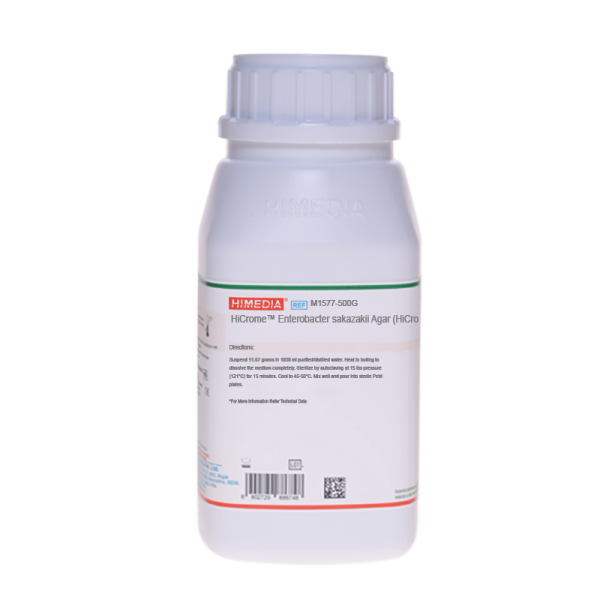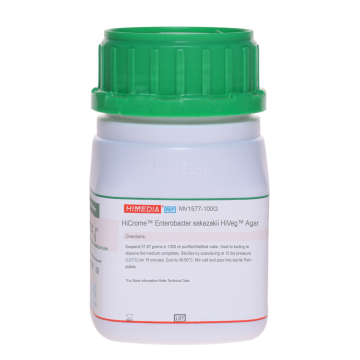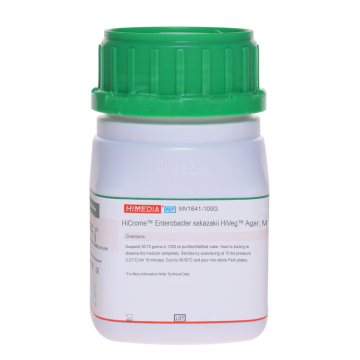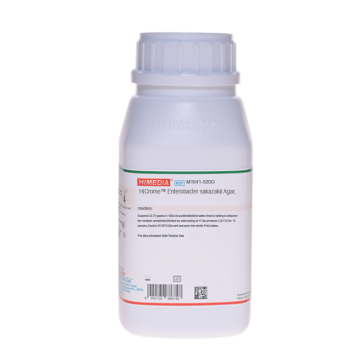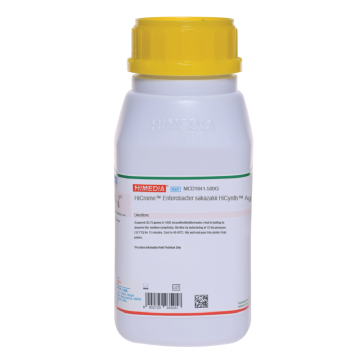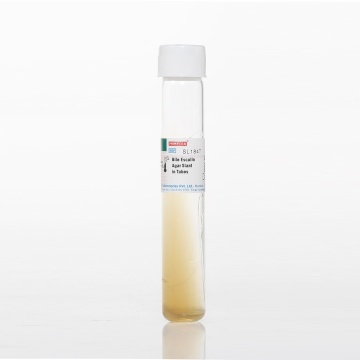 Your enquiry has been submitted
Your enquiry has been submitted
HiCrome™ Enterobacter sakazakii Agar (HiCrome™ Cronobacter sakazakii Agar
Intended Use
Recommended for the isolation and identification of Enterobacter sakazakii (Cronobacter sakazakii) from food, dairy products and clinical samples
Composition**
| Ingredients | g / L |
|---|---|
| Tryptone | 15.000 |
| Soya peptone | 5.000 |
| Sodium chloride | 5.000 |
| Sodium deoxycholate | 0.500 |
| Sodium thiosulphate | 1.000 |
| Chromogenic mixture | 10.170 |
| Agar | 15.000 |
Final pH ( at 25°C) 7.3±0.2
**Formula adjusted, standardized to suit performance parameters
Directions
Suspend 51.67 grams in 1000 ml purified/ distilled water. Heat to boiling to dissolve the medium completely. Sterilize by autoclaving at 15 lbs pressure (121°C) for 15 minutes. Cool to 45-50°C. Mix well and pour into sterile Petri plates.
Principle And Interpretation
Enterobacter species are widely distributed in nature occurring in fresh water, soil, sewage, plants, vegetables, animal and human feaces. *Cronobacter sakazakii has been closely associated with neonatal meningitis and sepsis (1). The chromogenic substrate in HiCrome™ Enterobacter sakazakii Agar is cleaved specifically (2) by the glucosidase enzyme possessed by Enterobacter species resulting in formation of blue-green colonies. Other organisms, which do not cleave this substrate, produce yellow coloured colonies. Incorporation of the chromogenic mixture in the media renders an intense blue colour to *Cronobacter sakazakii colonies whereas light blue green colour to the other Enterobacter species.
Tryptone and soya peptone provide nitrogenous and carbonaceous compounds, long chain amino acids, vitamins and other essential growth nutrients. Sodium chloride helps in maintaining the osmotic equilibrium of the medium. Sodium deoxycholate inhibits the accompanying gram-positive flora.
Key: *: Formerly known as Enterobacter sakazakii
Type of specimen
Clinical samples- faeces, bone marrow, etc.; Food and Dairy samples, Water samples
Specimen Collection and Handling
For clinical samples follow appropriate techniques for handling specimens as per established guidelines (2,3).
For food and dairy samples, follow appropriate techniques for sample collection and processing as per guidelines (4,5,6).
For water samples, follow appropriate techniques for sample collection and processing as per guidelines (7). After use, contaminated materials must be sterilized by autoclaving before discarding.
Warning and Precautions
In Vitro diagnostic use. For professional use only. Read the label before opening the container. Wear protective gloves/ protective clothing/ eye protection/ face protection. Follow good microbiological lab practices while handling specimens and culture. Standard precautions as per established guidelines should be followed while handling clinical specimens. Safety guidelines may be referred in individual safety data sheets.
Limitations
- Slight variation in colour may be observed depending on enzyme production by organism and substrate utilization from the medium.
- Individual organisms differ in their growth requirement and may show variable growth patterns on the medium.
Performance and Evaluation
Performance of the medium is expected when used as per the direction on the label within the expiry period when stored at recommended temperature.
Quality Control
Appearance: Light yellow to pink homogeneous free flowing powder
Gelling: Firm, comparable with 1.5% Agar gel
Colour and Clarity of prepared medium: Purple coloured, clear to slightly opalescent gel forms in Petri plates
Reaction: Reaction of 5.16% w/v aqueous solution at 25°C. pH : 7.3±0.2
pH: 7.10-7.50
Cultural Response
Cultural characteristics observed after an incubation at 35-37°C for 18-24 hours.
| Organism | Inoculum (CFU) | Growth | Recovery | Colour of Colony |
|---|---|---|---|---|
| Escherichia coli ATCC 25922 (WDCM 00013) | 50-100 | good-luxuriant | >=50% | yellow |
| Klebsiella pneumoniae ATCC 13883 (WDCM 00097) | 50-100 | good-luxuriant | >=50% | Green |
| Enterococcus faecalis ATCC 29212 (WDCM 00087) | >=104 | inhibited | 0% | |
| # Klebsiella aerogenes ATCC 13048 (WDCM 00175) | 50-100 | good-luxuriant | >=50% | bluish green |
| *Cronobacter sakazakii ATCC 12868 | 50-100 | good-luxuriant | >=50% | blue |
| Staphylococcus aureus subsp.aureus ATCC 25923 (WDCM 00034) | >=104 | inhibited |
Key: # - Formerly known as Enterobacter aerogenes, * - Formerly known as Enterobacter sakazakii
Storage and Shelf Life
Store between 15-25°C in a tightly closed container and the prepared medium at 2-8°C. Use before expiry date on the label. On opening, product should be properly stored dry, after tightly capping the bottle in order to prevent lump formation due to the hygroscopic nature of the product. Improper storage of the product may lead to lump formation. Store in dry ventilated area protected from extremes of temperature and sources of ignition Seal the container tightly after use. Product performance is best if used within stated expiry period.
Disposal
User must ensure safe disposal by autoclaving and/or incineration of used or unusable preparations of this product. Follow established laboratory procedures in disposing of infectious materials and material that comes into contact with clinical sample must be decontaminated and disposed of in accordance with current laboratory techniques (2,3).
Reference
- Muytjens H. L., Zanen H. C., Sonderkamp H. J. et al, J. Clin Microbiol 18:115-120, 1983.
- Isenberg, (2nd Ed.), Clinical Microbiology Procedures Handbook, Vol. 1, American Society for Microbiology, Washington,D. C.
- Jorgensen, J.H., Pfaller, M.A., Carroll, K.C., Funke, G., Landry, M.L., Richter, S.S and Warnock., D.W. (2015) Manual of Clinical Microbiology, 11th Edition. Vol. 1.
- American Public Health Association, Standard Methods for the Examination of Dairy Products, 1978, 14th Ed., Washington C.
- Salfinger Y., and Tortorello M.L., 2015, Compendium of Methods for the Microbiological Examination of Foods, 5th Ed., American Public Health Association, Washington, D.C.
- Wehr H. M. and Frank J. H., 2004, Standard Methods for the Microbiological Examination of Dairy Products, 17th Ed., APHA Inc., Washington, D.C.
- Lipps WC, Braun-Howland EB, Baxter TE,eds. Standard methods for the Examination of Water and Wastewater, 24th ed. Washington DC:APHA Press; 2023.
| Product Name | HiCrome™ Enterobacter sakazakii Agar (HiCrome™ Cronobacter sakazakii Agar |
|---|---|
| SKU | M1577 |
| Product Type | HiCrome™ |
| Physical Form | Powder |
| Origin | Animal |
| Packaging type | HDPE |
| References | 1.Muytjens H. L., Zanen H. C., Sonderkamp H. J. et al, J. Clin Microbiol 18:115-120, 1983.2.Isenberg, (Ed.), 1992, Clinical Microbiology Procedures Handbook, Vol. 1, American Society for Microbiology, Washington,D. C. |
| Customized Product Available | No |



